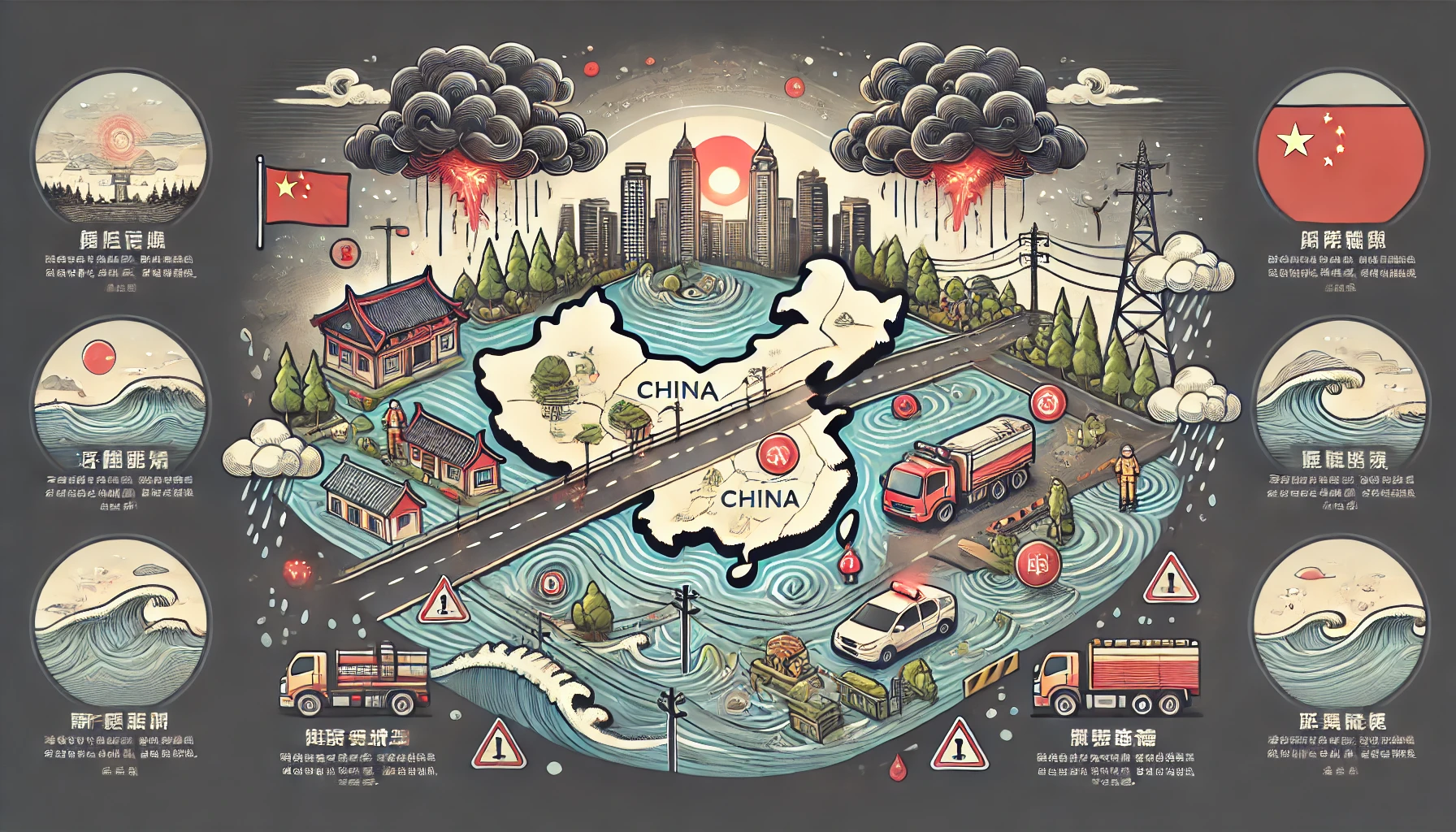China’s Battle Against Floods: Understanding Weather Alerts and the 2024 Flood Season
China is currently on high alert for heavy rain and floods from Typhoon Gaemi, which has put the nation on edge. The impact of such weather events on China’s infrastructure, agriculture, and population cannot be understated. This blog explores the intricacies of Typhoon Gaemi, the weather alerts issued, the 2024 flood season in China, and how the nation is managing this crisis.
Typhoon Gaemi: Tracking the Impact and Latest Updates
What is Typhoon Gaemi?
Typhoon Gaemi is a powerful tropical cyclone that has developed in the Pacific Ocean, making its way towards China. The name “Gaemi” is derived from a Korean word meaning “ant,” symbolizing the typhoon’s persistence and potential impact.
Impact of Typhoon Gaemi
Typhoon Gaemi has brought severe weather conditions, including heavy rains, strong winds, and flooding. The affected regions are experiencing disruptions in daily life, with significant damage to property and infrastructure. Coastal areas are particularly vulnerable, with rising sea levels exacerbating the situation.
Latest Updates on Typhoon Gaemi
Authorities have been providing regular updates on the typhoon’s path and its expected impact. Emergency services are on high alert, and evacuation plans are being implemented in the most affected areas. Continuous monitoring and timely updates are crucial in managing the impact of Typhoon Gaemi.
China Weather Alert: Preparing for Heavy Rain and Floods
Importance of Weather Alerts
Weather alerts play a vital role in preparing for natural disasters. They provide timely information to the public and authorities, enabling them to take necessary precautions and minimize the impact of adverse weather conditions.
Current Weather Alerts in China
China has issued several weather alerts in response to Typhoon Gaemi. These include warnings for heavy rain, strong winds, and potential flooding. The alerts are being broadcasted through various media channels to ensure that the public is well-informed and can take appropriate action.
Response to Weather Alerts
In response to the weather alerts, local governments have activated their emergency response plans. This includes setting up temporary shelters, distributing emergency supplies, and coordinating rescue operations. The public is advised to stay indoors, avoid traveling, and follow the instructions of local authorities.
China Floods 2024: An Overview
The 2024 Flood Season in China
The 2024 flood season in China has been particularly severe, with several regions experiencing unprecedented levels of rainfall. The combination of heavy rain and typhoon activity has led to widespread flooding, affecting millions of people across the country.
Impact of Floods on China
The floods have had a devastating impact on China, causing loss of life, displacement of communities, and significant damage to property. Agricultural areas have been hit hard, with crops destroyed and farmland submerged. The economic cost of the floods is expected to be substantial, with long-term implications for recovery and rebuilding.
Measures to Combat Flooding
To combat the flooding, China has implemented a range of measures. This includes constructing flood defenses, such as levees and dams, improving drainage systems, and enhancing weather forecasting capabilities. Additionally, efforts are being made to restore natural floodplains and wetlands, which can help absorb excess water and reduce the impact of floods.
Heavy Rain in China: A Closer Look
Causes of Heavy Rain in China
The heavy rain in China is primarily caused by the monsoon season, which brings significant moisture from the Indian Ocean and the Pacific Ocean. Typhoons, like Gaemi, can further intensify these conditions, leading to prolonged periods of heavy rainfall.
Regions Most Affected by Heavy Rain
Certain regions in China are more prone to heavy rain and flooding due to their geographical location and topography. Coastal provinces, such as Guangdong and Fujian, as well as river basins like the Yangtze and Yellow River, are particularly vulnerable.
Coping with Heavy Rain
To cope with the heavy rain, China has developed comprehensive flood management strategies. This includes early warning systems, flood forecasting, and emergency response plans. Public awareness campaigns are also conducted to educate communities on how to prepare for and respond to heavy rain and floods.
China Flood Warnings: Staying Safe
Importance of Flood Warnings
Flood warnings are crucial for ensuring the safety of people and property. They provide advance notice of potential flooding, allowing individuals and communities to take necessary precautions and evacuate if needed.
How Flood Warnings are Issued
In China, flood warnings are issued by the meteorological authorities and disseminated through various channels, including television, radio, and mobile apps. Social media platforms also play a significant role in spreading information quickly and efficiently.
Actions to Take During a Flood Warning
During a flood warning, it is important to follow the instructions of local authorities and take immediate action to protect yourself and your family. This includes:
- Moving to higher ground or an elevated location.
- Avoiding areas prone to flooding, such as riverbanks and low-lying regions.
- Keeping emergency supplies, such as food, water, and medical kits, readily available.
- Staying informed through reliable sources of information.
China Typhoon Season: What to Expect
Understanding Typhoon Season
Typhoon season in China typically lasts from June to November, with the peak occurring in August and September. During this period, the country can experience multiple typhoons, each bringing the risk of heavy rain, strong winds, and flooding.
Historical Data on Typhoons in China
Historical data shows that China has faced several devastating typhoons over the years. These events have highlighted the importance of preparedness and the need for effective disaster management strategies.
Preparing for Typhoon Season
To prepare for typhoon season, China has developed comprehensive plans that include:
- Strengthening infrastructure to withstand typhoon impacts.
- Conducting regular drills and simulations for emergency response teams.
- Educating the public on typhoon preparedness and safety measures.
China Disaster Management: Strategies and Challenges
Overview of Disaster Management in China
China’s disaster management system is designed to respond to a wide range of natural and man-made disasters. It involves coordination between various government agencies, local authorities, and the public to ensure a swift and effective response.
Key Strategies for Disaster Management
The key strategies for disaster management in China include:
- Early Warning Systems: Utilizing advanced technology to provide timely warnings of impending disasters.
- Infrastructure Resilience: Building and maintaining infrastructure that can withstand extreme weather conditions.
- Community Engagement: Involving communities in disaster preparedness and response efforts.
Challenges in Disaster Management
Despite significant progress, China faces several challenges in disaster management. These include:
- Climate Change: The increasing frequency and intensity of extreme weather events due to climate change.
- Urbanization: Rapid urbanization has led to increased vulnerability of cities to floods and other disasters.
- Resource Allocation: Ensuring that resources are allocated effectively to areas most in need during a disaster.
Conclusion
China is on high alert for heavy rain and floods from Typhoon Gaemi, highlighting the critical importance of weather alerts, flood warnings, and disaster management strategies. The impact of Typhoon Gaemi, combined with the ongoing 2024 flood season, underscores the need for effective preparation and response measures to protect lives and property. By understanding and utilizing weather alerts, flood warnings, and disaster management strategies, China can better cope with the challenges posed by natural disasters. For further information on disaster management and preparedness, visit Regent Studies.
In summary, the situation in China serves as a reminder of the power of nature and the importance of being prepared. Whether it is through early warning systems, community engagement, or infrastructure resilience, proactive measures are essential in mitigating the impact of disasters. By staying informed and prepared, we can better navigate the challenges posed by extreme weather events and protect our communities. For more resources and updates, visit Regent Studies and stay informed on best practices for disaster preparedness and management.




